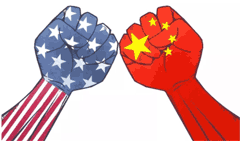Supply Chain Digest Says... |
 |
|
“The plain truth is it does not make sense to relocate to the United States the production of many products that require a lot of low-cost labor,” even with tariffs, the authors note, especially if labor cost is a high percentage of the bill of materials of a product.
|
|
 |
|
What do you say? |
|
| Click here to send us your comments |
|
| |
|
| Click here to see reader feedback |
|
|
|
It’s crazy times of course for companies dependent directly or indirectly on global trade relative to imports and exports. That would involve nearly every firm to a degree. Companies must determine how to proceed in a volatile and unpredictable tariff world, which looks increasingly like a giant trade war.
Just this week, China announced it was blocking international sales of so-called-called rare earth metals and batteries, materials essential to production of any array of products, including some electronics, batteries, and defense weaponry.
Add to that that even if a company feels an imperative to move its manufacturing back to US soil, the process may take years to complete or even be nearly impossible to achieve for supply reasons. Many companies are simply doing nothing, waiting to see how this all shakes out.
So what are companies and their supply chains supposed to do in the meantime?
In a recent column in the Harvard Business Review on-line, Harvard professor Willy C. Shih and MBA student Veronica Chua offer some advice. That includes the following:
Make sure your organization is prepared with country-of-origin documentation:
The authors say that no matter where tariff rates settle, it will be important to have thorough country-of-origin documentation in hand, documenting the country where a product was manufactured, produced, or substantially transformed.
That information in turn determines eligibility for trade preferences that may get enacted and will be essential to calculating tariff rates and ensuring compliance with import regulations and labeling laws.
“While this seems obvious, preparing the required documentation can be hard work- especially when components and subsystems cross borders multiple times as value is added,” the authors note.
Analyze the feasibility of your manufacturing locations:
The authors recommend that companies should take immediate steps to assess their current operations, including getting a breakdown of production costs and the feasibility of relocating manufacturing.
(See More Below)
|
CATEGORY SPONSOR: SOFTEON |
|
|
|
|
|
“The plain truth is it does not make sense to relocate to the United States the production of many products that require a lot of low-cost labor,” even with tariffs, the authors note, especially if labor cost is a high percentage of the bill of materials of a product.
Rethink the trading blocs in which you do business:
Many companies in recent years have at least looked at, if not adopted, regional manufacturing strategies. These strategies are viewed as a way to reduce risk from a high reliance on sourcing from China.
 But now with the tariffs, the authors say, managers need to focus much more on managing market risks on the demand side. Specifically, companies “should rethink the trading blocs and regions on which they’re overdependent for their sales - like the way many Canadian companies are extremely dependent on the US market. Canadian companies have come to realize that their dependence on the US market was undiversified, as have German firms with their overdependence on China.” But now with the tariffs, the authors say, managers need to focus much more on managing market risks on the demand side. Specifically, companies “should rethink the trading blocs and regions on which they’re overdependent for their sales - like the way many Canadian companies are extremely dependent on the US market. Canadian companies have come to realize that their dependence on the US market was undiversified, as have German firms with their overdependence on China.”
In conclusion, the authors write that “Businesses need consistent rules to make investment and sourcing decisions. At this point, it’s unclear when they will get rules they can count on. In the meantime, managers should prepare the best they can for continued turbulence in global trade.”
The full post can be found here: The Tariff Wars Just Upended Your Supply Chain. Here’s How to Adapt
What are your thoughts on Drewry's view? Let us know your thoughts at the Feedback section below.
Your Comments/Feedback
|

